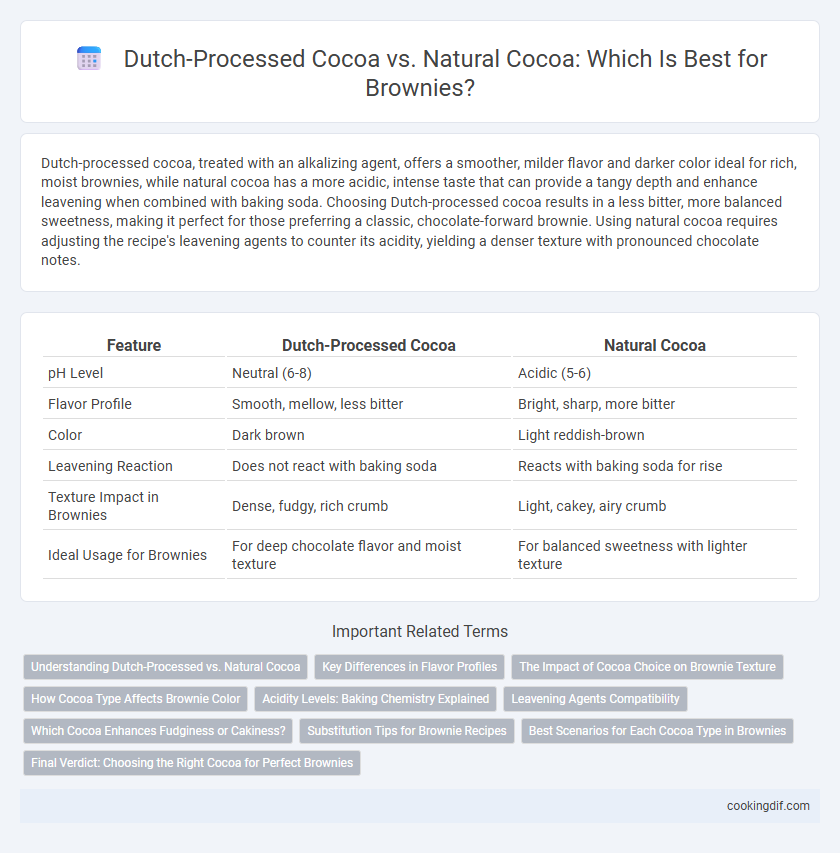Dutch-processed cocoa, treated with an alkalizing agent, offers a smoother, milder flavor and darker color ideal for rich, moist brownies, while natural cocoa has a more acidic, intense taste that can provide a tangy depth and enhance leavening when combined with baking soda. Choosing Dutch-processed cocoa results in a less bitter, more balanced sweetness, making it perfect for those preferring a classic, chocolate-forward brownie. Using natural cocoa requires adjusting the recipe's leavening agents to counter its acidity, yielding a denser texture with pronounced chocolate notes.
Table of Comparison
| Feature | Dutch-Processed Cocoa | Natural Cocoa |
|---|---|---|
| pH Level | Neutral (6-8) | Acidic (5-6) |
| Flavor Profile | Smooth, mellow, less bitter | Bright, sharp, more bitter |
| Color | Dark brown | Light reddish-brown |
| Leavening Reaction | Does not react with baking soda | Reacts with baking soda for rise |
| Texture Impact in Brownies | Dense, fudgy, rich crumb | Light, cakey, airy crumb |
| Ideal Usage for Brownies | For deep chocolate flavor and moist texture | For balanced sweetness with lighter texture |
Understanding Dutch-Processed vs. Natural Cocoa
Dutch-processed cocoa undergoes an alkalizing treatment that neutralizes its acidity, resulting in a smoother, more mellow flavor and darker color, while natural cocoa retains its acidic qualities with a sharper, more robust chocolate taste. When baking brownies, natural cocoa reacts with baking soda to create leavening, producing a lighter texture, whereas Dutch-processed cocoa requires baking powder for effective rise due to its neutral pH. Choosing between the two affects both the flavor profile and the texture of brownies, with natural cocoa offering a tangier bite and Dutch-processed cocoa providing a richer, more consistent chocolate flavor.
Key Differences in Flavor Profiles
Dutch-processed cocoa imparts a smooth, mellow, and less acidic flavor to brownies, enhancing chocolate richness with subtle earthiness. Natural cocoa offers a robust, tangy, and slightly bitter taste, providing a more intense cocoa flavor that complements the sweetness in brownies. The choice between Dutch-processed and natural cocoa significantly influences the overall flavor profile and texture, with Dutch-processed yielding a softer crumb and natural cocoa creating a fudgier, denser brownie.
The Impact of Cocoa Choice on Brownie Texture
Dutch-processed cocoa creates a smoother, more mellow brownie texture due to its alkalized treatment, which reduces acidity and enhances cocoa's solubility in the batter. Natural cocoa, being more acidic, reacts with baking soda to produce a lighter, fluffier brownie crumb with a slightly tangy flavor. Choosing between Dutch-processed and natural cocoa significantly influences the brownie's moistness, density, and overall mouthfeel.
How Cocoa Type Affects Brownie Color
Dutch-processed cocoa, treated with an alkalizing agent, produces brownies with a darker, richer color compared to natural cocoa, which imparts a lighter, reddish-brown hue. The pH level of Dutch-processed cocoa is higher, reducing acidity and enhancing Maillard reactions that deepen brownie color during baking. Choosing between these cocoa types significantly influences the visual appeal and perceived richness of brownies.
Acidity Levels: Baking Chemistry Explained
Dutch-processed cocoa undergoes an alkalizing treatment that neutralizes its acidity, resulting in a smoother, less bitter flavor and a darker color in brownies. Natural cocoa retains its acidic properties, which react with baking soda to create carbon dioxide bubbles, helping the brownies rise and develop a lighter texture. Understanding these acidity levels is crucial for adjusting leavening agents in brownie recipes to achieve the desired crumb and taste.
Leavening Agents Compatibility
Dutch-processed cocoa, being neutral in pH, reacts poorly with baking soda as a leavening agent, often resulting in denser brownies due to insufficient rise. Natural cocoa, which is acidic, activates baking soda effectively, producing a lighter, fluffier texture in brownies. For recipes using Dutch-processed cocoa, baking powder is preferred since it contains its own acid to ensure proper leavening and optimal brownie texture.
Which Cocoa Enhances Fudginess or Cakiness?
Dutch-processed cocoa, with its lower acidity and smoother flavor, enhances the fudginess of brownies by promoting a denser, moister texture. Natural cocoa, being more acidic, reacts with baking soda to create a lighter, cakier consistency in brownies. For rich, fudgy brownies, Dutch-processed cocoa is ideal, while natural cocoa suits those seeking a fluffy, cake-like bite.
Substitution Tips for Brownie Recipes
Dutch-processed cocoa, with its smooth, mellow flavor and darker color, can replace natural cocoa in brownie recipes by adjusting the leavening agents; use baking powder instead of baking soda since Dutch cocoa is neutral in acidity. Substituting natural cocoa with Dutch-processed requires reducing or omitting baking soda to prevent improper rising and achieve the desired fudgy texture. For recipe balance, consider enhancing sweetness or adding a pinch of baking powder to maintain the classic brownie density and moisture.
Best Scenarios for Each Cocoa Type in Brownies
Dutch-processed cocoa is ideal for brownies with a smooth, mellow flavor and deep color, especially when baking recipes that include baking powder as the leavening agent. Natural cocoa works best in recipes using baking soda, as its acidity reacts to provide lift and a more intense, tangy chocolate flavor. For fudgy brownies, Dutch-processed cocoa enhances richness, while natural cocoa is preferred for cakey brownies with a pronounced chocolate bite.
Final Verdict: Choosing the Right Cocoa for Perfect Brownies
Dutch-processed cocoa offers a smoother, less acidic flavor and darker color in brownies, making it ideal for a rich, fudgy texture. Natural cocoa provides a sharper, more pronounced chocolate taste that reacts well with baking soda, creating a lighter, cakey brownie. Selecting the right cocoa depends on your preferred brownie texture and flavor profile, with Dutch-processed best for dense fudginess and natural cocoa for airy softness.
Dutch-processed cocoa vs natural cocoa for brownies Infographic

 cookingdif.com
cookingdif.com